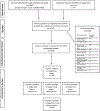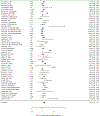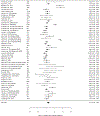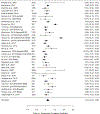Replication and reproducibility issues in the relationship between C-reactive protein and depression: A systematic review and focused meta-analysis
- PMID: 29928963
- PMCID: PMC6800199
- DOI: 10.1016/j.bbi.2018.06.016
Replication and reproducibility issues in the relationship between C-reactive protein and depression: A systematic review and focused meta-analysis
Abstract
One of the most common inflammatory markers examined in depression is C-reactive protein (CRP). However, the magnitude of the association between CRP and depression when controlling for potentially confounding factors such as age, sex, socio-economic status, body mass index, medication and other substance use, and medical illness, is unclear. Inconsistencies in other methodological practices, such as sample collection, assaying, and data cleaning and transformation, may contribute to variations in results. We aggregate studies that examined the association between CRP and depression in two ways. First, a systematic review summarizes how studies of CRP and depression have reported on methodological issues. Second, a tiered meta-analysis aggregates studies that have adhered to various levels of methodological rigor. Findings from the systematic review indicate a lack of protocol detail provided. The effect between depression and CRP was small, but highly significant across all stages of the meta-analysis (p < 0.01). The effect size in the most methodologically rigorous stage of the meta-analysis, which included studies controlling for age, sex, obesity, medical conditions and substance, medication, or psychosocial factors, was small (r = 0.05). There were also only 26 articles in this stage (13% of studies from the systematic review), suggesting that more studies that consistently account for these confounding factors are needed. Additionally, an a priori quality score of methodological rigor was a significant moderator in this stage of the meta-analysis. The effect size was strikingly attenuated (r = 0.005) and non-significant in studies with higher quality scores. We describe a set of recommended guidelines for future research to consider, including sample collection and assaying procedures, data cleaning and statistical methods, and control variables to assess.
Keywords: C-reactive protein; Depression; Meta-analysis; Reproducibility; Systematic review.
Copyright © 2018 Elsevier Inc. All rights reserved.
Figures








Comment in
-
What's CRP got to do with it? Tackling the complexities of the relationship between CRP and depression.Brain Behav Immun. 2018 Oct;73:163-164. doi: 10.1016/j.bbi.2018.08.003. Epub 2018 Aug 2. Brain Behav Immun. 2018. PMID: 30077590 No abstract available.
Similar articles
-
Sex differences in the inflammation-depression link: A systematic review and meta-analysis.Brain Behav Immun. 2024 Oct;121:257-268. doi: 10.1016/j.bbi.2024.07.037. Epub 2024 Jul 30. Brain Behav Immun. 2024. PMID: 39089535
-
Relationship between depression and C-reactive protein in a screening population.Psychosom Med. 2004 Sep-Oct;66(5):679-83. doi: 10.1097/01.psy.0000138132.66332.85. Psychosom Med. 2004. PMID: 15385691
-
Peripheral sub-inflammation is associated with antidepressant consumption in schizophrenia. Results from the multi-center FACE-SZ data set.J Affect Disord. 2016 Feb;191:209-15. doi: 10.1016/j.jad.2015.11.017. Epub 2015 Nov 26. J Affect Disord. 2016. PMID: 26674214
-
Confounders in Identification and Analysis of Inflammatory Biomarkers in Cardiovascular Diseases.Biomolecules. 2021 Oct 5;11(10):1464. doi: 10.3390/biom11101464. Biomolecules. 2021. PMID: 34680097 Free PMC article. Review.
-
Deployment of personnel to military operations: impact on mental health and social functioning.Campbell Syst Rev. 2018 Jun 1;14(1):1-127. doi: 10.4073/csr.2018.6. eCollection 2018. Campbell Syst Rev. 2018. PMID: 37131363 Free PMC article.
Cited by
-
Longitudinal associations between dimensions of maltreatment and internalizing symptoms in late adolescence: The role of inflammation during the COVID-19 pandemic.Brain Behav Immun Health. 2023 Dec 21;35:100719. doi: 10.1016/j.bbih.2023.100719. eCollection 2024 Feb. Brain Behav Immun Health. 2023. PMID: 38261884 Free PMC article.
-
Sick for science: experimental endotoxemia as a translational tool to develop and test new therapies for inflammation-associated depression.Mol Psychiatry. 2021 Aug;26(8):3672-3683. doi: 10.1038/s41380-020-00869-2. Epub 2020 Sep 1. Mol Psychiatry. 2021. PMID: 32873895 Free PMC article. Review.
-
Hierarchical Inflammatory Phenotypes of Depression: A Novel Approach Across Five Independent Samples and 27,730 Adults.Biol Psychiatry. 2023 Feb 1;93(3):253-259. doi: 10.1016/j.biopsych.2022.08.017. Epub 2022 Aug 22. Biol Psychiatry. 2023. PMID: 36802275 Free PMC article.
-
C-Reactive Protein as a Biomarker for Major Depressive Disorder?Int J Mol Sci. 2022 Jan 30;23(3):1616. doi: 10.3390/ijms23031616. Int J Mol Sci. 2022. PMID: 35163538 Free PMC article. Review.
-
Externalizing trajectories predict elevated inflammation among adolescents exposed to early institutional rearing: A randomized clinical trial.Psychoneuroendocrinology. 2019 Nov;109:104408. doi: 10.1016/j.psyneuen.2019.104408. Epub 2019 Aug 13. Psychoneuroendocrinology. 2019. PMID: 31442936 Free PMC article. Clinical Trial.
References
-
- Abbing-Karahagopian V, Huerta C, Souverein P, De Abajo F, Leufkens H, Slattery J, Alvarez Y, Miret M, Gil M, Oliva B, 2014. Antidepressant prescribing in five European countries: application of common definitions to assess the prevalence, clinical observations, and methodological implications. Eur. J. Clin. Pharmacol 70, 849–857. - PubMed
-
- Albert MA, Glynn RJ, Ridker PM, 2004. Effect of physical activity on serum C-reactive protein. Am. J. Cardiol 93, 221–225. - PubMed
-
- Alley DE, Seeman TE, Kim JK, Karlamangla A, Hu P, Crimmins EM, 2006. Socioeconomic status and C-reactive protein levels in the US population: NHANES IV. Brain Behav. Immun 20, 498–504. - PubMed
-
- Almeida OP, Norman P, Hankey GJ, Jamrozik K, Flicker L, 2007. The association between C-reactive protein concentration and depression in later life is due to poor physical health: results from the Health in Men Study (HIMS). Psychol. Med 37, 1775–1786. - PubMed
Publication types
MeSH terms
Substances
Grants and funding
LinkOut - more resources
Full Text Sources
Other Literature Sources
Medical
Research Materials
Miscellaneous

